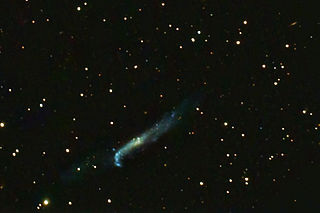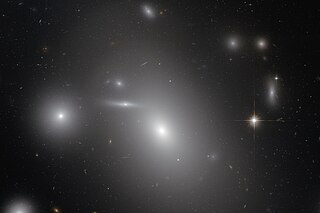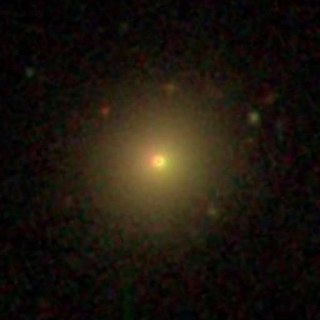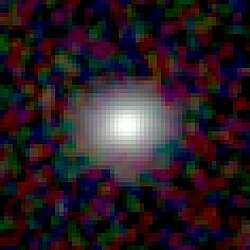
The New General Catalogue of Nebulae and Clusters of Stars is an astronomical catalogue of deep-sky objects compiled by John Louis Emil Dreyer in 1888. The NGC contains 7,840 objects, including galaxies, star clusters and emission nebulae. Dreyer published two supplements to the NGC in 1895 and 1908, known as the Index Catalogues, describing a further 5,386 astronomical objects. Thousands of these objects are best known by their NGC or IC numbers, which remain in widespread use.

NGC 281, IC 11 or Sh2-184 is a bright emission nebula and part of an H II region in the northern constellation of Cassiopeia and is part of the Milky Way's Perseus Spiral Arm. This 20×30 arcmin sized nebulosity is also associated with open cluster IC 1590, several Bok globules and the multiple star, B 1. It collectively forms Sh2-184, spanning over a larger area of 40 arcmin. A recent distance from radio parallaxes of water masers at 22 GHz made during 2014 is estimated it lies 2.82±0.20 kpc. from us. Colloquially, NGC 281 is also known as the Pacman Nebula for its resemblance to the video game character.

NGC 1, also occasionally referred to as GC 1, UGC 57, PGC 564 or Holm 2a is an intermediate spiral galaxy of the morphological type Sbc, located approximately 210 to 215 million light-years from the Solar System in the constellation Pegasus. It was discovered on 30 September 1861 by Heinrich d'Arrest.

NGC 17, also known as NGC 34, is a spiral galaxy in the constellation Cetus. It is the result of a merger between two disk galaxies, resulting in a recent starburst in the central regions and continuing starforming activity. The galaxy is still gas-rich, and has a single galactic nucleus. It lies 250 million light years away. It was discovered in 1886 by Frank Muller and then observed again later that year by Lewis Swift.

NGC 2976 is a peculiar dwarf galaxy in the northern circumpolar constellation of Ursa Major. It was discovered by German-born astronomer William Herschel on November 8, 1801, and catalogued as H I.285. J. L. E. Dreyer described it as, "bright, very large, much extended 152°, star involved". It is a member of the M81 Group and lies 1° 20′ to the southwest of Messier 81. The projected separation of this galaxy from the M81 Group is 190 kpc.

NGC 4656/57 is a highly warped barred spiral galaxy located in the constellation Canes Venatici and is sometimes informally called the Hockey Stick Galaxies or the Crowbar Galaxy. Its unusual shape is thought to be due to an interaction between NGC 4656, NGC 4631, and NGC 4627. The galaxy is a member of the NGC 4631 Group. A Luminous Blue Variable in "super-outburst" was discovered in NGC 4656/57 on March 21, 2005.
The Herschel 400 catalogue is a subset of William Herschel's original Catalogue of Nebulae and Clusters of Stars, selected by Brenda F. Guzman (Branchett), Lydel Guzman, Paul Jones, James Morris, Peggy Taylor and Sara Saey of the Ancient City Astronomy Club in St. Augustine, Florida, United States c. 1980. They decided to generate the list after reading a letter published in Sky & Telescope by James Mullaney of Pittsburgh, Pennsylvania, USA.

NGC 4889 is an E4 supergiant elliptical galaxy. It was discovered in 1785 by the British astronomer Frederick William Herschel I, who catalogued it as a bright, nebulous patch. The brightest galaxy within the northern Coma Cluster, it is located at a median distance of 94 million parsecs from Earth. At the core of the galaxy is a supermassive black hole that heats the intracluster medium through the action of friction from infalling gases and dust. The gamma ray bursts from the galaxy extend out to several million light years of the cluster.

NGC 249 is an emission nebula in the constellation Tucana. It was discovered on 5 September 1826 by the astronomer James Dunlop.

NGC 121 is a globular cluster in the Small Magellanic Cloud, in the constellation of Tucana. It was first discovered by John Herschel on September 20, 1835. The compiler of the New General Catalogue, John Louis Emil Dreyer, described this object as "pretty bright, pretty small, little extended, very gradually brighter middle".

NGC 117 is a lenticular galaxy with a magnitude of 14.3 in the constellation Cetus. NGC 117 is its New General Catalogue designation. It was discovered on September 13, 1863 by the astronomer Albert Marth.

NGC 156 is a double star located in the Cetus constellation. It was discovered on 1882 by Ernst Wilhelm Leberecht Tempel.

NGC 276 is a barred spiral galaxy located approximately 626 million light-years from the Solar System in the constellation Cetus. It was discovered in 1886 by Frank Muller and was later also observed by DeLisle Stewart.

NGC 965 is a spiral galaxy approximately 294 million light-years away from Earth in the constellation of Cetus. It was discovered by American astronomer Ormond Stone in 1886 with the 26" refractor at Leander McCormick Observatory.

NGC 6053 is an elliptical galaxy located about 450 million light-years away in the constellation Hercules. The galaxy was discovered by astronomer Lewis Swift on June 8, 1886 and is member of the Hercules Cluster.

NGC 717 is a lenticular galaxy located 210 million light-years away in the constellation Andromeda. The galaxy was discovered by astronomer Bindon Blood Stoney on October 28, 1850 and is a member of Abell 262.















